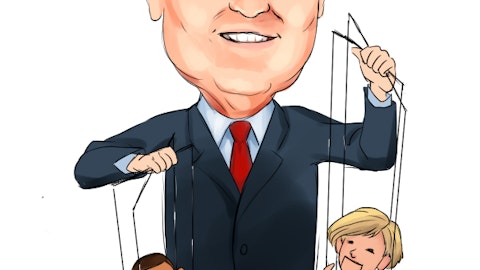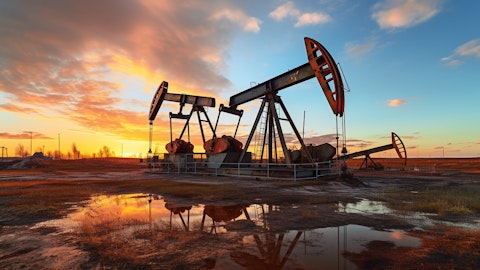Anthony Chovanec: This is Tony. Yes, essentially, you have seen no effect from the weak natural gas prices. If you and we show this slide often so that people understand it. If you look at what drives the economics of the producers in the Permian, it’s not natural gas. And you are – what we have seen in natural gas process is not going to cause people to shut in or even throttle back oil related natural gas at this point. We haven’t seen it. I guess proof is a little bit in the pudding. If you go and look at everybody has different rig counts, but if you go and look at rig counts in the Permian since the first of the year, they are steady as they can be, actually same can be said for the Eagle Ford producing rig counts down, in the Haynesville and you see them down somewhat in Appalachia, but not in your oily basins.
John McKay: Yes. That’s fair. Maybe just from petchemss, octane was pretty strong. Maybe just give us a quick read on how you would expect that to kind of roll out the rest of the year and maybe on the other side where we could expect kind of the PDH contributions to ten-fold as well? Thanks.
Chris D’Anna: Yes. John, this is Chris D’Anna, on the octane enhancement side, we benefited probably 80% of the improved performance was due to volumes and higher volumes and higher fees. And then we also had a favorable hedge performance. And I guess looking forward, if you look at the forward curve for normal RBOB, it shows pretty steady. So, we have at least for the second quarter $1.80 spread. And just a reminder for the biggest contributor for octane enhancement is our MTBE which is made-up of normal RBOB. And what we call uplift, which is just the market price, and really the difference between the normal RBOB spread and the market price. For your second question on PDH, we are expecting when PDH 1 and then with the return of PDH 2 after our outage in June that both of those assets are contributing back to their full amounts.
John McKay: I appreciate that. Thank you.
Operator: Thank you. [Operator Instructions] And our next question comes from the line of Neel Mitra from Bank of America, your question please.
Neel Mitra: Hi, good morning. Thanks for taking my questions. I wanted to ask about the activity within the first quarter. I think it was kind of universally accepted in the Permian that the first quarter would have a little bit of a lag versus the fourth quarter of ‘23. Just wanted to hear your insights of what you saw in terms of weather activity coming back and if you could kind of delineate that you are seeing some hot spots in production within the Permian and where you are seeing some lagging versus your initial expectations?
Brent Secrest: This is Brent. Relative to our first quarter, there was definitely an impact because of weather in the Midland Basin processing side. Our Delaware processing plants held up very well. On the Midland side, we had some downtime and it probably extended Graham for 10 days at some point. But that’s the reason there is probably an effect on volumes. But to Natalie’s point in terms of what we see as we go forward and we have a morning supply meeting that you guys are well aware of, it’s routine for every day that Natalie comes in to report our processing volumes that that’s up every single day.
Neel Mitra: So, is it fair to say that there has been a lot of flush production in kind of around the April timeframe after the first quarter?
Brent Secrest: Natalie, I mean we saw the increase our big jump on our side once our new plants came up.
Natalie Gayden: Yes. Once our new plants came up, we had some producers that, as you know, don’t have that acreage dedications, rather they just fling from we won market share. So, we – for example, when [indiscernible] came up, we were immediately full. So, I don’t know if I call it, first production from being down after the winter storm rather than just continue on pace, coming back up after the cold weather event.
Neel Mitra: Got it. And if I could sneak one more in there, it seem like the PGP RGP spreads were especially strong in the first quarter. Just wondering how that contributed to the first quarter results and if you see that as an ongoing trend for the rest of the year?
Chris D’Anna: Yes. This is Christian again. The RGP PGP spreads were wide for the first quarter. And you probably saw in the write up we had some operational issues on both our PDH and our splitter. So, there were there were some puts and takes there. And again, I think looking-forward, we see the contribution from our PDH plants running that’s going to going to help with our overall margin.
Neel Mitra: Okay. Great. Thank you.
Natalie Gayden: Operator, we have time for one more question.
Operator: Certainly, one moment, then for our final question. And our final question for today comes from the line of Neal Dingmann from Truist Securities, your question please.
Neal Dingmann: Good morning. Thanks for the time. My guys, just my question is on future cap allocation. I am just wondering you all boosted the – it looks like 2025 CapEx a bit based on opportunities out there. I am just wondering do you all have – when you look at future years, let’s just consider 2025 sort of the bogey or level for both shareholder return and projects. Just wonder how we should think about the balance between the two, as you start looking at ‘25 and ‘26.
Brent Secrest: Yes. Hey, Neal, good morning.
Neal Dingmann: Good morning.
Brent Secrest: What we had talked about at Analyst Day here a few weeks ago was really from a combination of distributions and buybacks, sort of operating in that 55% to 60% of adjusted cash flow from operations. We have sort of been in that zone since 2021. And that’s sort of what we foresee here for the next few years as well. As far as organic growth CapEx, again, seeing a lot of opportunities in the Permian and also with that the downstream benefits that come with that increased supply as it goes through our value chain. And now, with getting the license for a SPOT, we will be hustling to come in and get it contracted. So, I think we still come back with a bogey of what we put out in 2026 and that’s early is $2 billion and $2.5 billion of which only $800 million of that is currently approved projects.
So, we have got some room to fill that up including coming in and with SPOT. We are successful in getting that underwritten SPOT is really a 3-year construction cycle on that. And so anyway, I think that would help come in and address that $2 billion, $2.5 billion organic growth CapEx.
Neal Dingmann: No, that makes sense, right? And just quick follow-up, I won’t keep it just on the buybacks, just Randy, your thoughts on is that sort of as overall just earnings and cash flow keep ramping up just thoughts on would you do anything different with the buybacks or how that sort of factors in?
Randy Fowler: Yes. Neal, I think we will have more flexibility on buybacks. And again we look to be opportunistic with it. So, I mean you have seen us do $200 million or $300 million here over the last few years. I mean if there was a market dislocation, we have got the flexibility to do more. And then certainly, here in 2024 and 2025, we are looking at growth CapEx $3.25 billion to $3.75 billion range. I think once you get back out to 2026 2027, and if we are in a more of what I would say normalized CapEx range $2 billion, $2.5 billion, then we will have a lot more flexibility to do buyback then as well.
Neal Dingmann: Perfect. Thanks for the time Randy.
Operator: Thank you. This does conclude the question-and-answer session of today’s program. I would like to hand the program back to Libby Strait for any further remarks.
Libby Strait: Thank you everyone for joining us today. That concludes our remarks. Have a good day.
Operator: Thank you, ladies and gentlemen for your participation in today’s conference. This does conclude the program. You may now disconnect. Good day.
Follow Enterprise Products Partners L.p. (NYSE:EPD)
Follow Enterprise Products Partners L.p. (NYSE:EPD)
Receive real-time insider trading and news alerts





